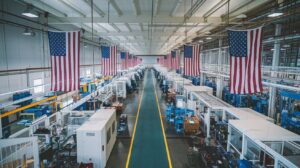Trump’s Tariffs Might Spark a U.S. Recession, Says JPMorgan – Here’s What It Means for You, as the leading investment bank warns that the former president’s sweeping trade penalties may push the American economy toward a serious downturn—impacting consumers, investors, and jobs across the nation.
What Are Trump’s Tariffs, and Why Are They a Big Deal?
In early April 2025, Donald Trump unveiled a bold new economic policy: a 10% blanket tariff on all imports to the United States, with higher rates on countries like China. While the intent is to protect American industries and reduce trade deficits, experts say these moves could have unintended consequences.
JPMorgan economists now estimate a 60% probability of a U.S. recession by the end of 2025, citing higher import costs, retaliation from trading partners, and slowed business investment.
How These Tariffs Could Impact Your Wallet and Daily Life
The average U.S. household could see costs rise between 1% and 1.5% in 2025 due to increased prices on imported goods—from clothing and electronics to groceries.
Tariff Impact:
| Item Category | Pre-Tariff Cost | Expected Price Hike | Consumer Impact |
|---|---|---|---|
| Electronics | $500 | +10% to 15% | +$50–$75 per product |
| Groceries (monthly) | $600 | +1.5% | +$9/month |
| Vehicles | $35,000 | +7% to 10% | +$2,450–$3,500 |
🔹 For families, this means tightening budgets and reconsidering large purchases.
JPMorgan’s Recession Forecast: What Wall Street Is Watching Closely
JPMorgan, one of America’s most trusted financial institutions, published a report stating:
“There will be blood in the market if the tariff shock is sustained.”
The S&P 500 fell 4.8% within days of the tariff announcement. Key sectors affected include:
- Tech companies relying on overseas components
- Retail chains importing consumer goods
- Automakers depending on global supply chains
This market shake-up is prompting a defensive shift in investment strategies.
What It Means for American Workers, Small Businesses & Investors
Beyond consumer prices, tariffs can disrupt hiring, wages, and small business operations. As companies absorb higher costs, they may:
- Delay new hiring or reduce hours
- Pass costs to consumers
- Shift production outside the U.S. to lower costs
Investors should diversify portfolios and avoid overexposure to global trade-dependent industries.
How to Protect Yourself Financially During Trade Tensions
Here’s what American households can do now to prepare:
- Track inflation reports monthly from the U.S. Bureau of Labor Statistics
- Rebalance investments toward stable, domestic-focused assets
- Cut discretionary spending and build emergency funds
- Support local products to limit exposure to tariff-driven price hikes
✅ Use tools like the CPI calculator and trade impact dashboards on U.S. Census Bureau
Tariffs — Intended Benefits vs. Economic Risks
[ Trump’s Tariffs ]
|
----------------------------
| |
[ Intended Benefits ] [ Economic Risks ]
| |
- Bring back jobs - Price inflation
- Reduce imports - Lower GDP growth
- Protect industries - Retaliation from China
- Investment pullback
- Market volatility
Will Tariffs Strengthen or Sink the U.S. Economy?
While Trump’s tariffs are designed to project American strength, they come with real risks. JPMorgan’s 60% recession warning cannot be ignored. From grocery aisles to Wall Street, Americans are already feeling the tremors of this economic gamble.
Informed decision-making is crucial—whether you’re a consumer, investor, or policymaker. Stay updated, review your finances, and prepare for more economic turbulence in 2025.
Subscribe to trusted news sites like USnewsSphere.com for continuous updates, deep analysis, and expert commentary on America’s evolving economy.
[USnewsSphere.com / ba]





